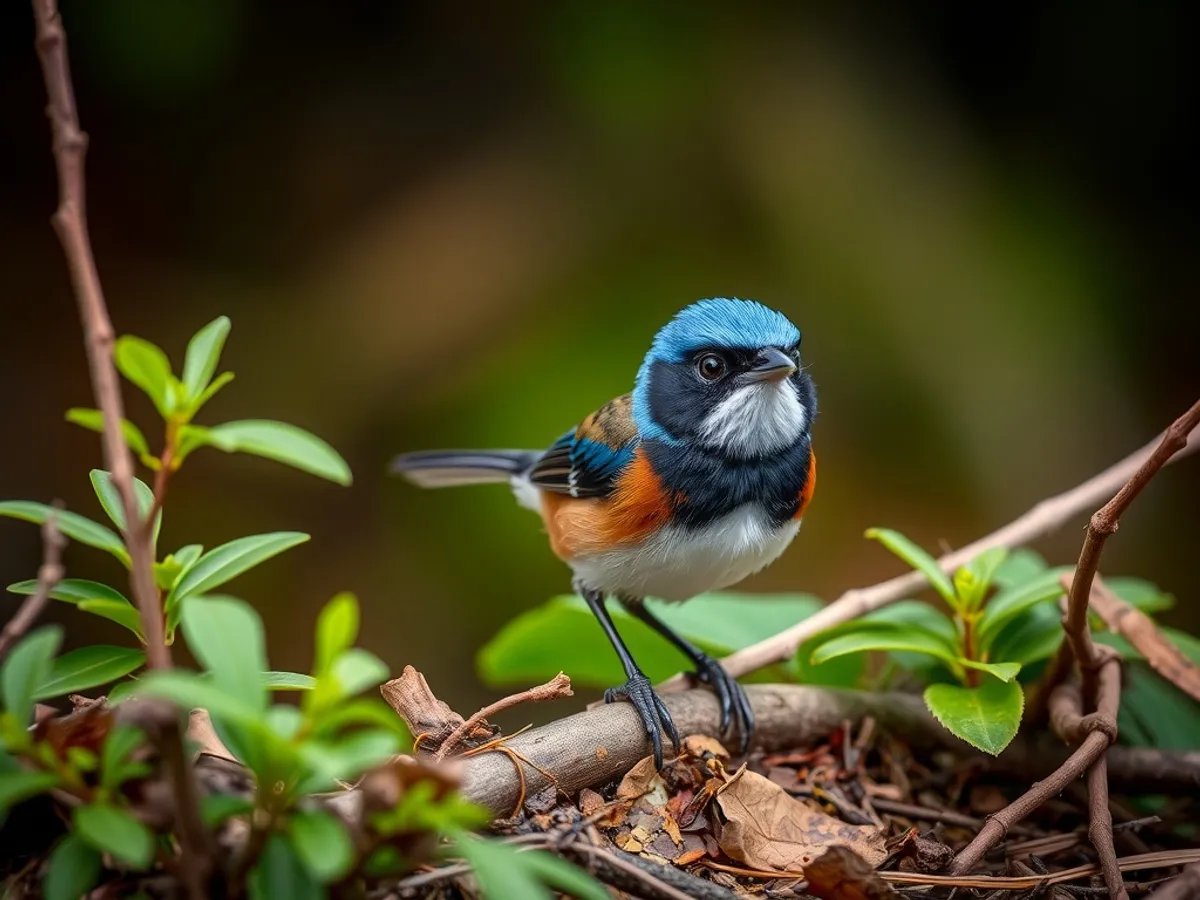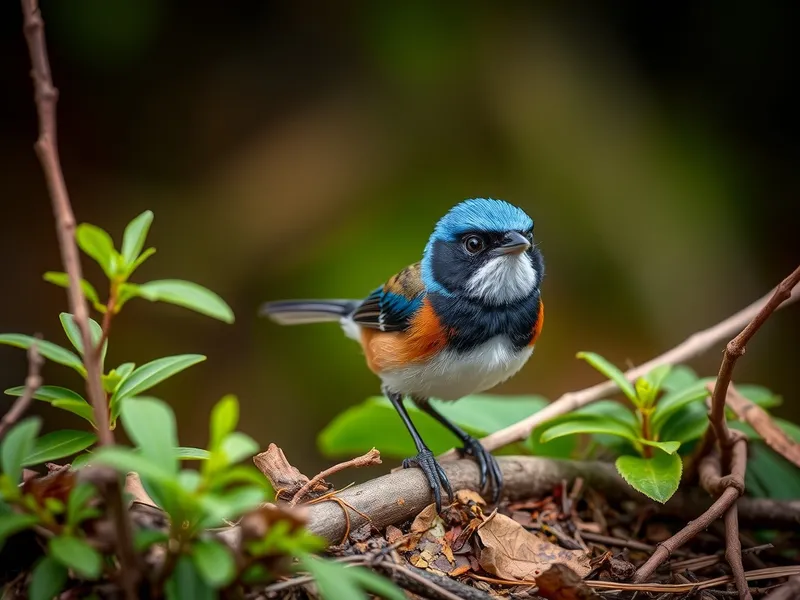
Superb Fairywren
Malurus cyaneus

Meet the Superb Fairywren
The Superb Fairywren is a small, active songbird native to southeastern Australia, renowned for the striking blue and black plumage of the adult male, especially during the breeding season. Females and non-breeding males are mostly brown with a pale underbelly, providing excellent camouflage in their shrubby habitats. These birds are highly social, often living in cooperative groups that help raise offspring collectively. Superb Fairywrens are known for their lively, energetic movements as they flit through dense vegetation, foraging for insects and seeds.
Classification
Bird
Habitat
Woodlands, forests, shrublands, and urban gardens
Diet
Omnivore
Lifespan
5-7 years
Conservation
Least Concern
Weight
8–13 grams
📖Fascinating Facts
Striking Breeding Plumage
During breeding season, adult males develop vivid blue and black feathers, making them stand out against their environment.
Cooperative Breeders
Superb Fairywrens live in groups where non-breeding individuals help care for the young, enhancing survival rates.
Flower-Petal Gifts
Males often present brightly colored flower petals to females as part of elaborate courtship displays.
📋Detailed Description
The Superb Fairywren (Malurus cyaneus) is a diminutive passerine, typically measuring 14–16 cm in length, with a long, slender tail often held upright and a body mass averaging 8–13 grams. Males in breeding plumage display vibrant cobalt-blue and black markings on the head, throat, and upper back, contrasted by a pale blue tail and brownish wings; outside the breeding season, males molt into an 'eclipse' plumage similar to the cryptic brown of females. Females and juveniles are predominantly warm brown above and buff-white below, with a subtle blue wash in the tail. The bill is short and conical, adapted for insectivory, and both sexes possess strong legs for agile movement through dense undergrowth. Superb Fairywrens are highly active, exhibiting rapid, low flights and frequent tail flicking. They are social birds, forming stable, cooperative breeding groups that defend territories year-round. Vocalizations are complex, including high-pitched trills and alarm calls, with males known for their dawn chorus. The species is renowned for its promiscuous mating system, with both sexes engaging in extra-pair copulations, resulting in broods with mixed paternity. Their nests are dome-shaped structures, intricately woven from grasses and spider webs, concealed within dense vegetation. Superb Fairywrens are adaptable, thriving in a range of habitats from native woodlands and heathlands to suburban gardens, and are often observed foraging in small, cohesive groups.
💡 Did you know?
Superb Fairywrens have been observed presenting flower petals to females as part of their courtship behavior.
🔬Research & Sources
Wikipedia Summary
The superb fairywren is a passerine bird in the Australasian wren family, Maluridae, and is common and familiar across south-eastern Australia. It is a sedentary and territorial species, also exhibiting a high degree of sexual dimorphism; the male in breeding plumage has a striking bright blue forehead, ear coverts, mantle, and tail, with a black mask and black or dark blue throat. Non-breeding males, females and juveniles are predominantly grey-brown in colour; this gave the early impression that males were polygamous, as all dull-coloured birds were taken for females. Six subspecies groups are recognized: three larger and darker forms from Tasmania, Flinders and King Island respectively, and three smaller and paler forms from mainland Australia and Kangaroo Island.
Last Modified: 5/25/2025
🎭Behavior & Social Structure
Superb Fairywrens are diurnal and exhibit a pronounced social structure, typically living in groups comprising a dominant breeding pair and several subordinate helpers, often offspring from previous broods. These groups cooperate in territory defense, predator vigilance, and feeding of nestlings. Foraging occurs primarily on or near the ground, with individuals gleaning insects, spiders, and small arthropods from foliage, bark, and leaf litter; seeds and small fruits are also consumed, especially outside the breeding season. The species is known for its 'rodent-run' distraction display, where adults feign injury to lure predators away from nests. Males frequently carry brightly colored petals (often yellow) as courtship displays to females, a behavior thought to signal fitness. Daily routines involve periods of foraging interspersed with preening, social interactions, and vocal communication. Territorial boundaries are maintained through song and physical displays, with aggressive encounters occurring at territory edges.
👶Reproduction & Life Cycle
Breeding occurs primarily from spring to late summer (August to February), though timing varies with latitude and rainfall. The species is socially monogamous but genetically promiscuous; both sexes engage in extra-pair matings, resulting in high rates of extra-pair paternity (up to 76% of offspring in some populations). The female constructs the nest alone, laying 2–4 eggs per clutch. Incubation, performed solely by the female, lasts 13–15 days, while both the female and group members (helpers) participate in feeding the chicks. Nestlings fledge after 10–12 days but remain dependent on the group for several weeks. Multiple broods may be raised within a season, especially in favorable conditions. Cooperative breeding enhances offspring survival, with helpers increasing feeding rates and nest defense.
🛡️Adaptations & Survival
Superb Fairywrens exhibit several notable adaptations: their cryptic non-breeding plumage provides camouflage against predators, while the male's striking breeding colors enhance sexual selection. The long tail aids maneuverability in dense vegetation. Their complex social system, including cooperative breeding and helper retention, increases reproductive success and resilience to environmental variability. Behavioral adaptations such as the rodent-run display and alarm calls improve nest survival. Vocal mimicry, including the ability to incorporate predator calls into their own repertoire, may serve as an anti-predator strategy. Physiologically, they are capable of surviving in a range of habitats, from wet forests to arid shrublands, by adjusting foraging strategies and diet.
🎨Cultural Significance
The Superb Fairywren is a beloved species in Australian culture, frequently featured in art, literature, and folklore. Its striking appearance and lively behavior have made it a popular subject for birdwatchers and nature enthusiasts. In some Aboriginal traditions, fairywrens are associated with messages or omens. The species is often used as a symbol of the Australian bush and is a flagship species for urban wildlife conservation initiatives. Its presence in gardens is considered a sign of a healthy, biodiverse environment.
🔬Recent Research & Discoveries
Recent research has focused on the species' complex mating system, revealing high levels of extra-pair paternity and the evolutionary drivers of cooperative breeding. Studies using molecular genetics have elucidated kinship structures within groups and the benefits of helper retention. Behavioral ecologists have investigated the function of petal-carrying displays and the role of vocal mimicry in predator avoidance. Ongoing research addresses the impact of urbanization on behavior, reproductive success, and genetic diversity. Superb Fairywrens have also been model organisms for studies on sexual selection, social evolution, and the effects of environmental change on avian populations.
🎥Wildlife Videos

Superb Fairywren 4K - Iconic Australian Birds
It's hard not be smitten by these little beauties. They flit about like they don't have a care in the world. The males typically take the ...
Last Volcano

Superb Fairywren
Spring is here and the Superb fairywrens have returned to the property. I shot this yesterday over about and hour. They're funny ...
Shoalhaven Image Network

Fairywren Superb
Fairywren superb.
Plumes of Oz

Superb Fairy Wrens 2020
a series of male and female Superb Fairy Wrens photographed around home through a couple of seasons.
Richard Avon

The Flutter and Chirp of Superb Fairy-Wrens
Superb Fairy-Wren Scientific name: Malurus cyaneus Appearance: These striking little birds are the most well known of Australia's ...
Nature Enthusiast

Superb Fairy wren Videos
A compilation of the Superb Fairy-wren videos captured by myself and my son over the past few years. #superbfairywren ...
Matt Hinze
🌍Habitat Information
The Superb Fairywren typically inhabits Woodlands, forests, shrublands, and urban gardens environments. Superb Fairywrens have adapted to their environments with specialized features and behaviors.
Primary Habitat:
Woodlands, forests, shrublands, and urban gardens
More detailed habitat information will be available soon.
🛡️Conservation Status
The Superb Fairywren is currently classified as Least Concern. Conservation efforts are crucial for preserving this species for future generations.
Common Threats:
- 🏠Habitat loss and fragmentation
- 🌡️Climate change impacts
- 🎯Hunting and poaching
- 🏭Human-wildlife conflict
⚠️Threats & Conservation Challenges
Currently listed as Least Concern by the IUCN, Superb Fairywrens remain widespread and locally common. However, habitat fragmentation, urbanization, and predation by introduced species (notably domestic cats and foxes) pose ongoing threats, particularly in peri-urban areas. Nest predation by native and introduced mammals, reptiles, and birds is a significant cause of breeding failure. Climate change may alter habitat suitability and food availability, potentially impacting population dynamics. Despite adaptability to modified landscapes, loss of dense understory vegetation reduces nesting sites and shelter, making populations vulnerable in heavily cleared regions.
🔬Scientific Classification
Scientific Name
Malurus cyaneus
Classification Hierarchy
🔍 About Taxonomic Classification
Taxonomic classification is a hierarchical system used by scientists to classify and organize living organisms based on shared characteristics and evolutionary relationships.
The system moves from broad categories (Kingdom) to increasingly specific ones, with each animal's scientific name typically consisting of its Genus and species.
📝Community Notes
Share your observations and insights about the Superb Fairywren with our community of wildlife enthusiasts.
Join Our Community
Sign in to share your observations and connect with fellow wildlife enthusiasts.
Sign In to ContributeNo community notes yet
Be the first to share your observations about the Superb Fairywren!
Explore Superb Fairywren
Select a tab above to learn more about this amazing animal.
📸Photo Gallery
No photos available for this animal yet.
🌟Discover More Wildlife
Continue your journey of discovery with more fascinating animals from our database
